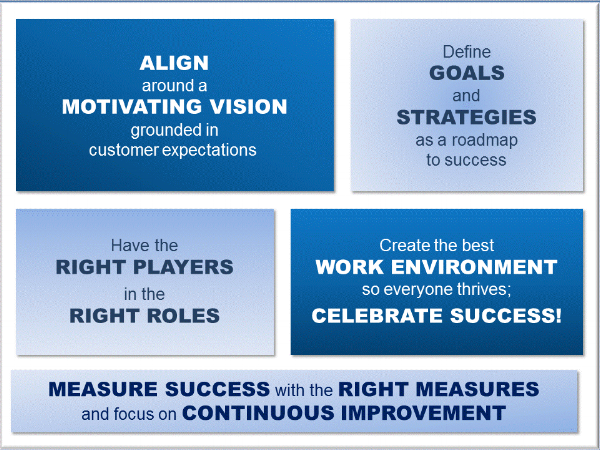Leadership Model
We work with executives, teams, and learning leaders, leveraging this proven LEADERSHIP MODEL.
We personally crafted and used this comprehensive leadership model to create award-winning Fortune 100 learning teams. Over the course of several decades of working with other leaders and teams, we have identified that those who adopt this model achieve truly winning results! This model was also featured on Training Magazine's website.
1. Align around a motivating vision grounded in customer expectations
Defining an inspirational vision is a critical first step in providing the direction and motivation to achieve higher success. This vision needs to be grounded in “what success looks like” for your company and business – based on customer expectations. As trite as it may sound, if you can’t identify what success means to you, how will you know if you achieve it? Include what satisfaction looks like for your employees, customers and stockholders. If yours is a publicly held company, review the past year’s annual report; really understand and accept your strengths and especially your opportunities. Your vision should be a motivating statement – one that’s tied to stakeholders, and that’s a stretch for the organization. Everyone on the team and all those you lead should be able to relate to it,… repeat it,… and confidently and enthusiastically explain it. The vision statement should be incorporated into your daily language and interaction with others.
2. Define goals and strategies as a road map to success
Once you have a motivating vision crafted, define the key goals and strategies that need to be in place. These become the roadmap to your destination. Then identify the critical actions that must be executed to move you along the right path. Leaders and team members should focus on those that will have the greatest impact on desired results.
3. Have the right players in the right roles
To have the right players in the right roles, you have to start by hiring the right people. Hire only the best and brightest – A players. It’s not only much easier to accomplish your goals when you have strong players, it’s downright impossible to accomplish them with weak players. Recruit, hire, train and develop team players who have the ability and passion to bring your vision to life. Ensure workload is broken down into manageable chunks, then match the skills of each individual so they can accomplish their best work.
4. Create the best work environment so everyone thrives; celebrate success!
Create an environment that allows people to not just do good work, but to really thrive as they’re doing it! People do their best work when they feel comfortable bringing their “whole selves” (mind, body and spirt) to work. Take the time to get to know what motivates your team; what really jazzes them! Most people work for a person, not for the company, so stay connected with them as individuals. Recognizing and celebrating successes is a strong motivator to keep team members productive and engaged. My motto is: “Celebrate what you want to see more of… and you’ll get it!”
5. Measure success with the right measures and focus on continuous improvement
The first Leadership principle entailed defining a vision for what success looks like. But to know if you’re on track along the way – and if/when you achieve it – you need to measure your progress. Develop “lag” and “lead” goals, along with associated measures that can be efficiently and accurately captured. Lag goals are those interim goals or indicators that will help you hit your lag measures. Create a Scoreboard… then use it! Review it regularly and adjust actions/tactics as required to positively impact the score. Establishing regular check-in routines will give you and the team the opportunity to recognize and celebrate progress, which creates energy to keep going forward, or make needed course corrections at the right times. These routines also provide the ideal opportunity for feedback -- a tremendous gift when given and received! Your Scorecard also becomes the basis for continuous improvement as you set and achieve ever-higher goals that improve the business.

